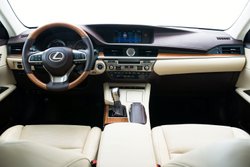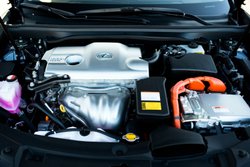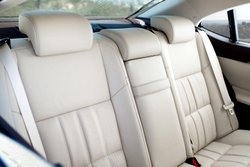Relentless, But Now Aggressive
For years Lexus has used the tagline, “The relentless pursuit of perfection,” in its advertising and marketing. That mantra has led to a significant amount of brand recognition for reliability, customer satisfaction and, of course, luxury.
The automaker’s pursuit is showcased in the gasoline-electric hybrid 2016 ES 300h and its gasoline-powered counterpart, the ES 350.
With its striking design, scrumptious interior and many features borrowed from the flagship LS 460, the ES sedan is not only alluring, but completely fulfills its role as the Lexus designee in the entry-level luxury segment. Adding to the allure, the ES 300h hybrid version has an EPA estimated fuel economy rating of 40 mpg city/39 mpg highway and 40 mpg combined.
Styling That Is Distinctive
Over the years, Lexus has been ultra conservative in redesigning the ES sedan, yielding body styles that were evolutionary. Often times it was difficult to distinguish a new model from the outgoing one.
Totally redesigned for the model year 2013, this generation’s styling approach was aggressive, resulting in a design that is arresting, yet quietly dynamic. What has become a defining Lexus hallmark, the distinctive spindle grille, was given an even more dramatic look for 2016, flanked by swept-back High-Intensity-Discharge headlamps.
A coupe-like roof, high beltline, flared fenders and narrow windows give an impression not seen in previous ES cars—slightly aggressive.
The ES 300h conveys its hybrid status in subtle ways, with specific split-five-spoke 17-inch alloy wheels, lip spoiler, hidden exhaust pipe and blue hybrid badges.

The 300h opens wide into a richly equipped and carefully assembled passenger compartment with the exacting fit and finish expected in a Lexus car. NuLuxe faux leather with striking bamboo wood trim in our test drive car combined to create a warm, tasteful and refined ambience.
Dash design is elegantly simple, highlighted by a small, round analog clock. Developed by Lexus, Opti-tron lighting neutralizes any annoying reflections, making it easy to read the instrument gauges. Per Lexus custom, audio and climate controls are well placed and intuitive.
Standard front 10-way adjustable seats are firm and multi-hour comfortable. Rear seat passengers will appreciate the 40 inches of legroom—the most in the midsize class—and even tall adults will find it a comfortable place to ride.
Like many hybrid cars, the battery pack is located in the rear, reducing trunk capacity to 12.1 cubic feet compared to the 15.2 cubic feet in the ES 350. Pack luggage wisely though, and there’s enough space for a family of four’s two-week vacation trip.
It’s hard to criticize the ES 300h, but the Lexus Remote Touch system’s mouse-like controller for the screen cursor frustrated me at times. This is a feature that comes with the available navigation and infotainment packages. It is ultra-sensitive to operate, and just when I thought I had mastered the right touch, I discovered I hadn’t.
There is just one model, the ES 300h, and it includes an impressive list of standard features: Power everything, multi-information display, automatic climate control, moonroof, an eight-speaker CD audio system, auxiliary jack, USB port, Bluetooth connectivity, satellite radio and more.
Lexus prices the 2016 ES 300h starting at $41,995 including $975 destination charges, which is only $3,000 more than the base ES 350. Our example was equipped with a long list of options, including several safety systems, the navigation system and the Ultra Luxury package. These added $7,550, bringing the total to $49,410—not exactly chump change.
Lexus Hybrid Synergy Drive

Giving the ES its “hybrid” credentials is the Hybrid Synergy Drive that powers other Lexus and Toyota hybrid models. It combines a low-friction 2.5-liter four-cylinder Atkinson-cycle engine with an AC synchronous traction motor and a motor/generator.

Engine output of 156 horsepower and 156 pound-feet of torque are merged via computer control with the traction motor that supplies 142 horsepower and 199 pounds-feet of peak torque. Combined output is rated at 200 horsepower.
The second motor is a motor/generator that is primarily engine driven. During coasting and regenerative braking, it recharges the 1.6-kilowatt liquid-cooled nickel-metal hydride battery pack. It also is used as the starter for the gas engine during the stop-start operation.
A continuously variable transmission (CVT), the only transmission available, directs push to the front wheels.
Selectable drive modes give the driver system power output and driving characteristics flexibility. Normal mode is the best blend of efficiency and power for every day driving. Eco mode favors fuel economy, while Sport mode adds some get-up-and-go. There is also an EV mode, which allows short-distance electric-only driving.
ES 300h Road Test
Quietness is a major asset of the ES 300h. Wind rush and road noise are nearly absent at highway speeds, allowing conversations with passengers at normal voice levels. The Atkinson-cycle engine will make itself known when power is put down, but the transition between the electric motor and engine power is not only quiet, but the action is near seamless.

Quickness in not a part of the ES 300h’s resume, but its 0 to 60 mph time of around 7.8 seconds is reassuring when it’s time to merge into fast-moving freeway traffic. When an extra spurt of power is needed, Sport mode delivers better acceleration derived from added torque provided by the electric assist motor.
The ES 300h has stable front-drive moves, but the low-rolling resistance tires provide only modest grip in turns. Engineers have tuned the suspension to deliver a balance weighted more towards comfort than handling precision. Still, the ride is firm enough to fly down back roads or up the highway without concern.
Steering is laudably accurate for a hybrid sedan, but it is light and offers only a small amount of feedback. Brakes are also impressive for a hybrid. There is no brake shudder and no sense of when regenerative braking (which recharges the battery pack) gives way to the traditional hydraulic brake system.
As for fuel economy, the ES 300h delivers as advertised. It isn’t difficult to operate the car on electric power with the engine shut off, enabling fuel economy to increase. This can be accomplished in town and occasionally on the highway.
Driving most of the time at the legal go-with-the flow pace for 405 miles rewarded us with 41.7 mpg—slightly better than the EPA estimate of 40 mpg.
In The Marketplace

While gasoline-electric hybrid vehicles are well established in the automotive marketplace, there are only a few luxury automakers that offer a fuel sipping hybrid powertrain. With six hybrids in the lineup, it’s no surprise that Lexus is the leader in luxury hybrid sales.
When it comes to luxury hybrid sedans, the 2016 ES 300h has scant competition. The 2016 Lincoln MKZ Hybrid matches the ES hybrid’s 40 mpg combined fuel economy and has a starting price that is $5,000 less. However, it isn’t quite as roomy and can’t match the ES 300h when it comes to all-out luxury and refinement.
Infiniti’s rear-wheel drive Q70 Hybrid with a V-6 engine is aimed more at performance than fuel economy, which is reflected in its EPA fuel economy of 29 mpg city/33 highway and 31 combined. Plus, it starts at $56,805.
If you are willing to forgo the cache of a luxury nameplate, loaded versions of Toyota’s Avalon Hybrid and the Ford Fusion Hybrid deliver similar amenities and fuel economy. And their bonus is: prices are lower—$32,665 for the Fusion, $38,995 for the Avalon.
The 2016 Lexus ES 300h isn’t perfect, but it is a spacious, quiet sedan for the driver who wants to escape the humdrum of daily driving. In the end, it is a compelling choice if you want a truly premium car along with fuel economy that only a hybrid can offer.
Related Stories You Might Enjoy:
Road Test: 2016 Lexus GS 450h
Road Test: 2016 Lexus CT 200h
Road Test: 2016 Lexus ES 300h (another opinion)
News: 2017 Lincoln MKZ Hybrid
Road Test: 2014 Toyota Avalon Hybrid
Disclosure:
Clean Fleet Report is loaned free test vehicles from automakers to evaluate, typically for a week at a time. Our road tests are based on this one-week drive of a new vehicle. Because of this we don’t address issues such as long-term reliability or total cost of ownership. In addition we are often invited to manufacturer events highlighting new vehicles or technology. As part of these events we may be offered free transportation, lodging or meals. We do our best to present our unvarnished evaluations of vehicles and news irrespective of these inducements.
Our focus is on vehicles that offer the best fuel economy in their class. We also feature those that are among the top mpg vehicles in their class. In addition, we aim to offer reviews and news on advanced technology and the alternative fuel vehicle market. We welcome any feedback from vehicle owners and are dedicated to providing a forum for alternative viewpoints. Please let us know your views at publisher@cleanfleetreport.com.

0 thoughts on “Road Test: 2016 Lexus ES 300h”